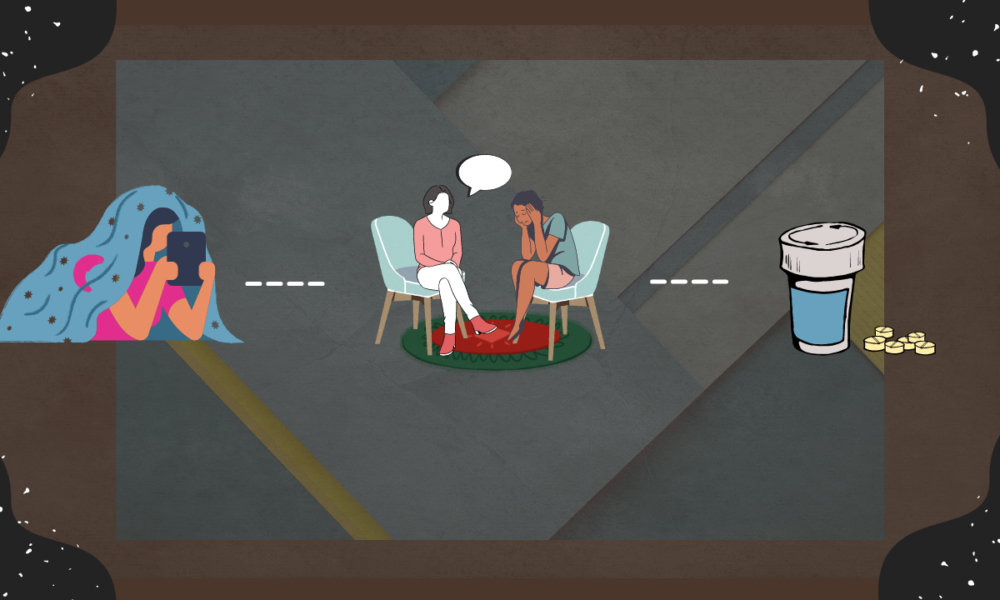Raise a hypothetical hand if the following phrase sounds familiar: “Put a finger down challenge, mental health edition.”
For those who have no idea, “put a finger down” is a popular TikTok trend. The host of the video lists off several characteristics or habits and the viewer puts down a finger for every trait they identify with.
At the end of the game, the host tells the viewer the purpose of their result, such as which Hogwarts House they belong in, if they had strict parents, or what mental health condition they might have.
The concern over these videos is the possibility of a self-diagnosis of a mental disorder in young impressionable viewers. Similar videos have done the same for other mental health conditions, such as anxiety and depression.
While these TikToks may create a virtual safe space for the millions of subscribers who consume its mental health content, there seems to be a trend of young adults convincing themselves they have a mental disorder.
Dr. Mark Ragins, a psychiatrist at Long Beach State, says this is the result of a culture with an illness mindset.
“We live in a medical model era where we explain emotional and mental distress as illnesses or conditions,” Ragins said.
Ragins said he often receives students who struggle to pay attention in class or focus on homework assignments, claiming these issues might be related to attention deficit hyperactivity disorder (ADHD).
“They are expressing their distress using the language of mental illnesses,” Ragins said.
The American Psychological Association (APA) developed the Diagnostic and Statistical Manual of Mental Disorders (DSM-5) for a psychiatrist to use when diagnosing a patient. The manual lists several symptoms which correlate with a mental illness.
If the patient meets a majority of the symptoms, they are diagnosed with a mental disorder and are prescribed medication.
Ragins referred to the DSM-5 as a mere “screening tool” at best. The symptom checklists for ADHD seen on TikTok most likely came from the DSM-5, he said.
“Those are just symptoms that correlate with the conditions,” Ragins said. “They are confusing causes with effects.”
What a psychiatrist doesn’t do, he said, is figure out why a patient is experiencing those symptoms in the first place.
The pandemic, for example, has triggered symptoms of anxiety and depression, according to the CSULB psychiatrist. Reported rates of anxiety and depression in adults were four times higher between April 2020 and August 2021 than in 2019.
Younger people, Ragins added, are more likely to admit to cases of anxiety and depression since their generation was more accepting of the idea of mental health issues.
Online mental health care companies, such as Cerebral and BetterHelp, have placed advertisements on TikTok. These companies have made mental health treatment easier to access, as well as online prescriptions for medication.
Medication prescribed for ADHD has doubled within the last decade, according to a 2018 study. The same study revealed there was a 41% increase in ADHD prevalence in U.S. children in 2011 compared to the same prevalence in 2003. This prevalence is anticipated to increase after the 2013 publication of DSM-5, which has broadened to include ADHD diagnosis in adults.
The viral TikTok videos listing symptoms related to ADHD are also treated by stimulants such as Adderall.
“We’re getting more and more people on more and more pills,” Ragins said. “When you look at it, the vast majority of conditions today do have a cause and we are responsible.”
The causes Ragins referred to included eating too much, not exercising regularly, drinking too much caffeine, smoking too much pot, and so on.
Even when therapists suggest a wellness model with techniques to avoid aggravating mental illness symptoms, there is still an illness-disease mindset. When a person goes on a run with the purpose to avoid depression, the illness mindset is still there.
However, there is a new type of model called the person-centered model.
“That says you are born with whoever you are,” Ragins said. “And then life happens. Sometimes it’s warm and supportive and you really blossom and grow. Sometimes it’s traumatic and you end up bent and broken.”
The goal of this form of therapy is to help people learn how to take back control of their own life. Instead of dismissing their issues as a mental health disorder, the individual works with a therapist to understand why they are experiencing those issues.
“Notice that difference between saying ‘Let’s make a diagnosis and get rid of something’ and ‘Let’s recognize something that is part of me,'” Ragins said. “Suffering is to be learned from, not necessarily to be gotten rid of.”
People could learn to embrace their imperfections, instead of looking for a pill that alters them to be the person they’re “supposed” to be.




